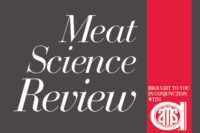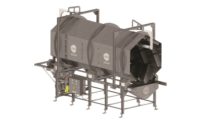Introduction: What is biopreservation?
Biopreservation encompasses a number of food-preservation strategies, ranging from ancient methods such as fermentation to modern technologies including bacteriocins and bacteriophages.
In U.S. food industries today, biopreservation can be defined as the use of non-pathogenic microorganisms that antagonize or inhibit the growth of undesirable pathogenic and/or spoilage microbes through their metabolic activity or capacity to compete for nutrients or attachment niches, or the use of chemical compounds that have been fermented and then purified.
Our discussion here will be limited to biopreservation incorporating the use of microorganisms that inhibit, inactivate or antagonize other microorganisms.
Biopreservation methods can be used to enhance food safety by complementing other food-preservation processes, and due to their gentle nature can be used in situations where harsher treatments are undesirable, such as in fresh or minimally processed foods.
Biopreservation on meat and poultry products
Multiple non-pathogenic bacterial organisms antagonize and/or inhibit the growth of other bacterial microorganisms (including foodborne pathogens) through the metabolism of antimicrobial compounds or through competition for nutrients.
The bacterial genera collectively known as the Lactic Acid Bacteria (LAB) have been extensively researched for their abilities to inhibit growth of bacterial pathogens on both fresh and processed meat or poultry products. Species of Lactobacillus, Lactococcus, Pediococcus, Streptococcus and others have been researched extensively to inhibit pathogens on meat and poultry products, including Escherichia coli O157:H7, Salmonella enterica, Clostridium spp. and Listeria monocytogenes. Scientists have identified pathogen-inhibiting LAB species that exert antimicrobial activity through fermentation of organic acids (primarily lactic acid but also acetic acid), hydrogen peroxide, biosurfactants and antimicrobial polypeptides (bacteriocins).
The USDA currently approves two food antimicrobials composed of pathogen-antagonizing bacterial microorganisms (USDA-FSIS Directive 7120.1, Rev. 16).
One product is composed of differing microorganisms and can be applied to different types of fresh and processed products, including poultry carcasses, non-standardized comminuted meats, various ready-to-eat products and cured whole-muscle products. The product contains species of Lactobacillus and Pediococcus and is listed as “Generally Recognized as Safe” by the FDA (GRAS Notice #000171).
An antimicrobial composed of the heterofermentative organism Carnobacterium maltaromaticum is approved in the U.S. and in Canada for application to RTE deli-type products as an antilisterial intervention. These products are also available to processors of organic meat or poultry products under the USDA’s National Organic Program (7CFR205).
Obstacles to using pathogen-antagonizing microorganisms
One of the biggest hurdles to using fermentative bacterial organisms is the potential for undesirable food spoilage by the metabolic activity of the fermentative microbes. Although antimicrobials are useful for pathogen control, fermentation also can lead to producing large amounts of gas, as well as compounds that contribute off-flavors, off-odors or loss of textural acceptability. These concerns might be overcome through selection of organisms that produce antimicrobial compounds but do not contribute to detectable spoilage during storage, or potentially through the use of genetically engineered organisms that will produce pathogen-antagonizing antimicrobials but not overproduce other fermentative metabolites.
Bacteriophages: What are they?
Bacteriophages (or phages) are a group of viruses that only infect bacteria. Phages are believed to have been around for almost as long as bacteria, and in many environments, phages are their top predators.
Phages can be found almost anywhere bacteria are found — soils, oceans, surface waters, as part of the microflora of animals (including humans) and in fermented foods. In fact, phages are believed to be the most abundant form of life on Earth, numbering some 1031 organisms.
Phages kill bacteria by using them as their hosts (see Figure 1 above). A phage uses protein receptors on its coat to recognize a specific surface feature on its host cell. It then permanently attaches to the host and ejects its DNA into it. In the killer phages commonly used as antibacterials (“virulent” phages), this phage DNA directs the cell away from its own metabolism and toward the production of new phage.
After a brief time, usually 20 to 40 minutes under ideal conditions, the phage lyses the host cell, killing it and releasing 50 to 200 newly made phages into the environment, where they are free to bind to other hosts in the vicinity and continue their life cycle. From this simplified view of the phage life cycle, one can see several potentially beneficial antibacterial properties of phages.
First, they are specific, typically infecting a subset of strains within a bacterial species, meaning they will not disrupt non-targeted bacterial populations. Second, they replicate, meaning a low number of phages could potentially eventually control a much larger population of bacteria. Other advantages include activity at ambient temperatures, moderate ionic strength and neutral pH, and virtually no effects on the flavor or texture of the food.
Where could phages be used in foods?
Because phages are specific for their host bacteria, phages are more suited for the control of pathogenic bacteria, which fall into a relatively narrow spectrum of bacterial species. While they do not possess their own metabolism, phages are organisms composed of protein and DNA, and thus are sensitive to many of the same intrinsic and extrinsic factors that affect bacteria.
Extremes of pH, oxidizers, reactive compounds, chelating agents, extreme heat and radiation will inactivate phages with kinetics roughly similar to those for bacteria. Similarly, because the phage must locate its host through a process of passive diffusion, phages would not be expected to function well in dried products or while frozen, although they may remain viable in this state and regain activity if conditions became more favorable.
Phages are generally expected to be stable but less active at refrigeration temperatures, although there is considerable variability between phages and bacteria in this regard. Based on this, the application of phages would appear to make the most sense as part of an initial treatment for raw product, in minimally processed foods or as a finishing treatment following harsher processing steps.
Phage-based products have been approved for use as food additives in the U.S., including products intended to combat L. monocytogenes, E. coli O157:H7 and Salmonella, with products reportedly in development for Campylobacter and “the Big 6” STECs. Recommended applications for these products include pre-slaughter hide treatments in cattle, packaged RTE meats and fish, cheeses and produce.
In lab experiments, phages have been effective in reducing foodborne pathogen counts in the surface contamination of fresh produce, processed and raw meats, seafood and cheeses. Phages have also been effective when added to pasteurized fluid milk and incorporated into cheese. Most of the peer-reviewed data on the efficacy of phage-based antibacterials in foods comes from such lab experiments, typically using foods artificially contaminated with known pathogen strains. While these phage products are available, there is relatively little data on their market penetration and use.
Potential for biopreservatives
Given the continued research interest in the antagonism of microbial pathogens by fermentative, non-pathogenic microorganisms, the recent steep incline in the rate of new phage-based antimicrobials obtaining regulatory approvals for use in foods, and the advent of new genetic engineering technologies and synthetic biology systems, the opportunities for the development of new pathogen-inhibiting biopreservation technologies appear ripe for use by the foods industry.
Although more comprehensive validation of the utility of biopreservatives for differing FSIS-inspected products is still needed for industry members seeking to use such technologies for food-safety protection, biopreservation offers processors new opportunities to enhance the microbiological safety of fresh and RTE products.





Report Abusive Comment